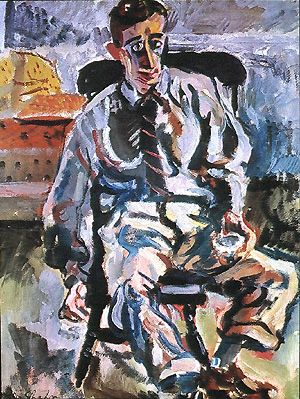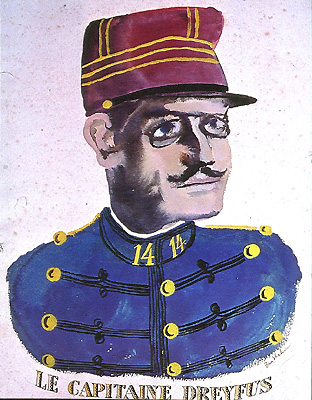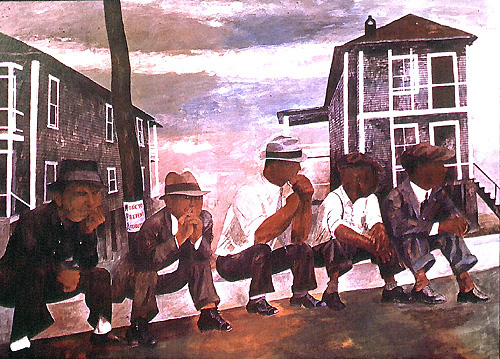 |
For Ben Shahn, the years 1929-31 were a pivotal time of stylistic and
thematic changes in which photography played a crucial role. It has been
established that the photographer Walker Evans was responsible for introducing
Shahn to photography.1 However, the “profound difference”2 embedded
in the two artists’ conception of photography has rarely been discussed.
Shahn and Evans never compromised their artistic visions regarding the
compatibility of art and ideology; Shahn consistently attempted to convey
his reformative social visions through his pictorial narratives, whereas,
in treating a variety of themes ranging from the documentary to formal
abstraction, Evans maintained neutral and detached attitudes toward the
subject matter of his photographs. An analysis of Shahn’s two portraits
of Evans and The Dreyfus Affair, all done in 1930, and some of Evans’s
photographs taken and published in 1928-30 may provide a clue to characterize
their different approaches to art.
Shahn, a Russian-Jewish immigrant whose father was a woodcarver and active
socialist, became aware of the corruption interwoven into the fabric of
society and sympathetic toward the victims of social injustice. In adapting
to his new country, Shahn experienced new, yet no doubt familiar, forms
of anti-Semitism, “more subtle than those enforced by the Russian
Czar, but no less effective in maintaining a social hierarchy.”3
Although he had been making a living as a lithographer since his late
teens, Shahn prepared to be a painter.4
During his trips to Europe in the 1920s,5 Shahn, while experimenting with
the Post-Impressionst and Fauvist styles of Cézanne, Matisse, Rouault,
and Dufy, was also exposed to George Grosz’s critical visual narrative.
In 1925, four years prior to his encounter with Evans, Shahn saw in Vienna
a copy of Ecce Homo (1922) by Grosz. In retrospect, Shahn revealed that
he was deeply moved by the drawing: “I almost dropped dead in excitement
over it.”6 He bought a copy. Within the drawings, an acid sarcasm
towards bourgeois indulgence in sexual pleasure is conveyed through lively
charged, razor-sharp lines. Its revealing content and narrative brevity
might have provided Shahn with an excellent model. Shahn, however, was
never drawn to the erotic themes that the German artist often depicted
to represent bourgeois moral perversity. Through Grosz, who began his
career as a graphic artist and whom Shahn admired as “the greatest
draftsman of this century,”7 Shahn perhaps confirmed his desire to
develop from a draftsman to an artist revealing social reality. After
Grosz came to New York, Shahn would visit him in 1933 and 1935 and be
given two drawings.8 Shahn enthusiastically groped for an appropriate
style to express narrative messages, yet he still had not found his own
style by the time he met Evans.
Unlike Shahn, Evans was critical of the cultural pretensions of American
bourgeois society. Despite his sheltered middle-class background, he rejected
the security of bourgeois life. Even his attempt to become a photographer
seemed to be “a willful act of protest against a polite society in
which young men did what was expected of them.”9 In his biography,
Evans recalled “My poor father, for example... decided that all I
wanted to do was to be naughty and get hold of girls through photography,
that kind of thing. He had no idea I was serious about it. And respectable,
educated people didn’t. That was a world you wouldn’t go into.
Of course, that made it more interesting for me, the fact that it was
perverse.”10 In 1927 Evans returned to New York after spending one
year in Paris and decided to become a photographer. Like “a conventional,
if well-groomed, bohemian,”11 Evans toured the city taking pictures
while supporting himself through a series of temporary jobs.
 |
In the late 1920s, Evans was assimilated to a kind of
objective realism. The writing of Flaubert that he had avidly read in
Paris and the early photographs of Paul Strand among others inspired him
in that direction. Paul Strand’s Blind Woman, 1916,(fig. 2) was a
powerful source.12 Evans was drawn to the photographer’s frontal
representation of the old blind woman, which minimized the traces of the
artist’s emotional response to his subject. Ultimately, realistic
content and objective authorship formed two axes of Evans’s photographic
world. In an interview Evans stated: “I think I incorporated Flaubert’s
method almost unconsciously, but anyway I used it in two ways; both his
realism, or naturalism, and his objectivity of treatment. The non-appearance
of the author. The non-subjectivity. That is literally applicable to the
way I want to use a camera and do.”13
Within this frame of logic, Evans had access to realistic
themes of documentary photography that had specific references to American
life at a specific moment and to modernism’s rational and reductive
formal structure. Throughout his career, Evans’s pictures incorporate
a range of diverse themes, from the lives of ordinary people to the structural
abstraction.
Evans’s New York photographs of 1928 and 1929 demonstrate his double
interest in formal abstraction and the documentation of American life.
Within balanced compositions and formidable contrasts of black and white,
his pictures portray anonymous pedestrians, clerks working in shops, workers
resting on the street. One of his first published photographs, printed
in Creative Art of December 1930, shows a busy lunch counter scene in
the city.
These various themes represent Evans’s tendency toward
a neutral observation of the lives of the city’s denizens. Another
group of Evans’s photographs of this time demonstrates his photographic
exploration of geometric composition. These pictures focus on architectural
patterns and the spatial relationships of modern buildings. A photograph
taken in 1928 or 1929 published in Architectural Record in 1930 even recalls
Charles Sheeler’s Criss-Crossed Conveyors, Ford River Rouge Plant,
1927 in its diagonally crossing composition seen from below. The Precisionist’s
articulation of the precise structures underlying the machine and the
architecture may have reinforced Evans’s photographic experiments
with reductive abstraction.
 |
Shahn and Evans were intellectually attracted to each
other when they first met in September 1929. Just after his return from
Europe, Shahn saw Evans at the home of a mutual friend, Dr. Iago Geldston.
At Shahn’s insistence,14 Evans moved into the ground-floor studio
of Shahn’s apartment at 21 Bethune Street in Greenwich Village. The
Shahns lived on the two floors directly above Evans’s studio and
Shahn painted in his own living room.15 As Judith Shahn, the artist’s
daughter, recalled, “Evans was like a member of the family; he was
frequently invited upstairs for supper in the kitchen.”16 “For
Evans,” observed his biographer Berlinda Rathbone, “no one could
have been a better ally at that moment than the energetic and canny Ben
Shahn.”17 According to Bernarda Bryson Shahn, who met Shahn in 1933
and two years later became his wife, “Both artists initially enjoyed
each other’s witty, free-minded personalities.”18 Central to
their free-mindedness was a shared subversive attitude regarding established
bourgeois society. While Evans’s concern was geared more toward bourgeois
cultural prejudices, Shahn’s was toward art’s positive function
as ideological reformation.
Shahn had been interested in photography before he met Evans and began
taking pictures in the early 1930s.19 Amongst Strand’s early “straight”
photographs that register minute details and the subtle tonal ranges of
objects, his photographs of pedestrians especially impressed Shahn. “Learning
from Strand, Shahn often turned his attention to the individual in the
urban setting,” observed art historian Susan Edwards.20 Both Shahn
and Evans welcomed straight photographs to the extent that they later
discussed collaborating on a photography book in which they would oppose
both the artificiality of Pictorialist subjects such as female nude 21
and the blurry mechanism of the soft-focus Pictorialism. They rejected
romantic subject matter and idealizing techniques, but Shahn was further
drawn to the humanistic content of Strand’s early photograph and
its critical potential to reveal an underside of society.
In 1930, while working on the subject of The Dreyfus Affair,22 Shahn painted
two portraits of Evans. The portraits show expressive styles of Shahn’s
pre-photographic period. Shahn’s painterly representations of the
photographer suggest the complex nature of the two artists’ acquaintanceship;
for Shahn, a portrait meant the painter’s critical observation of
the sitter, rather than a flattering resemblance.23
On the simplest level, the two portraits show Evans sitting on a chair.
One is painted in oil(fig. 1), the other in watercolor . The canvas of
the oil portrait is thickly painted with agitated brushstrokes in bright
colors. Evans, in a dress shirt, is arrested in an action while sitting
on a wooden chair with his legs spread and holding a camera lens, an evident
marker of his profession. The broad contouring used in some parts, the
freedom of brushstrokes, and the sporadically applied blue, orange, and
dark brown recall Georges Rouault’s early watercolors to which the
French painter often added pastel for heavy texture. In comparison, Shahn
shows clearer spatial order and emphasizes the fluidity of brushstrokes,
creating a more overall elegance than Rouault.
Shahn divided the watercolor portrait into three transparent color-patches:
blue, covering the area of the battered wicker chair and the upper body
of Evans; white, Evans’s trousers; and a light wash in pale yellow
of the surrounding area. While making each color-patch into a concrete
shape, the calligraphic and elliptical contours and linear details added
later not only give the patches vibrating rhythms, but also enliven the
freshness of each color without reducing the color to a function of simple
representation. Within this overall scheme, the torso of Evans is barely
distinguished by the few flowing lines from the chair in which he is slouching.
His shoulders are hunched and his hands are digging into his pockets.
The transparent colors and calligraphic linear details are associated
with Raoul Dufy’s painting; unlike the Fauve, who depicted figures
in a more stylized manner, Shahn emphasizes the individuality of the sitter.
Within both portraits, Evans’s likeness is captured through free
yet concise details. Evans’s sensitive or “squeamish”24
personality is suggested through his physiognomy, unique pose, and neat
costume. Hardly the idealized type of portraiture, the activated brushstroke
and bodily exaggeration evoke a sense of intense psychological and intellectual
exchanges between the painter and the sitter. Neither portrait contains
any obvious iconographic sign that proves Shahn’s critical apprehension
of the photographer, but Shahn’s expressive form and color connote
the essential difference embedded in their art; at this time Shahn chose
to reject formalist-modernism in favor of a more realistic representation
conveying concrete narrative contents. Shahn, who acknowledged in 1929
that “the French school is not for me,”25 baptized Evans with
the painterly style of the French school, colorfully characterized the
detached nature of Evans’s modernist aestheticism, and covertly differentiated
the photographer from himself.
 |
During the summer of 1930, Shahn and Evans had a two-day
joint exhibition in the barn of a Portuguese neighbor on Cape Cod, where
they spent the summer. Shahn hung The Dreyfus Affair (fig. 4), a series
of works created specially for the exhibition and Evans exhibited his
photographs of the neighbors, the Deluze family.
The Alfred Dreyfus Affair, the case of the Jewish officer in the French
Army falsely accused of treason, shook France in the 1890s. Participating
in political protests in Paris over the more recent Sacco and Vanzetti
case in America (the trial of two anarchist Italian immigrants convicted
of murder on flimsy evidence), Shahn perceived the Dreyfus case to be
a similar conspiracy of the social system against ethnic minorities and
the working class.
To create The Dreyfus Affair, Shahn first used published photographic
images as models.26 From photographs in the relevant books, old magazines
and news articles, he painted the major players in the Dreyfus trial.
Fine details are added to broad washes of facial area and clothing to
characterize the faces and costume decorations. The backgrounds are left
empty or covered with a pale wash. Each portrait has the carefully lettered
name in different scripts, the hard edges of which are in sharp contrast
with the washed areas of a figure. Despite the quick application of washes,
each portrait shows proper bodily proportion, clear features, and additive
details drawn with exactness. The Dreyfus Affair demonstrates Shahn’s
magnificent graphic skill attained through lithographic training. The
shaded areas of the faces suggest volume and space, yet most of the portraits
are painted flat. The optical flatness is reinforced by the impersonal
arrangement of the letters. The shallow space and fine details are possibly
transferred from the photograph, in which abrupt changes of light and
shade often cause similar flat effects. The overall transparent colors
of The Dreyfus Affair, however, do not effectively emphasize the seriousness
of the historical trial. This lightness would disappear with the emphatic
patterns--the darker tonalities, nervously broken lines, and an undercurrent
of distortion--of The Passion of Sacco and Vanzetti that he began to paint
the following year.
One of the Deluze photographs exemplifies Evans’s photographic treatment
of the subject. The interior scene shows a prickly cactus plant set against
the framed family photographs, a souvenir American flag, and a vase of
dried flowers. Through the straight photographic technique, both photographs
keep the same degree of descriptive exactitude for the objects from the
foreground to the background. Particularly in the photograph of the cactus
plant within an airless space, the equally distinctive contours and the
scattered dark areas, in strong contrast to the white wall, push the photographed
objects all-over to the picture plane. This reductive formal process of
the photographic still life helps objectify its content, the commonplace
American domestic space.
Taken slightly later, however, Hudson Street Boarding House Detail (1931-33)
shows an interior scene of a bedroom. In this bedroom picture, the decorative
quality is retained by the curvilinear patterns of the wrought-iron bed
and the black and white contrast of the bedspread and surrounding areas.
However, the shabby interior--the rough wall, the drooped curtains, and
the sunken mattress—reveals an economically dire situation. Here,
the decorativeness of this photograph collides with its unavoidable suggestion
of a specific relation to the outside world; this collision of formal
abstraction and social implication makes possible multiple ways of appreciation
and interpretation of the work. In this way, Evans refused to assign a
predefined meaning to his photography.
Evans’s emphasis upon the absence of the author was another unacceptable
point to Shahn, who was conscious of the artist’s social contribution
through critical interpretation and active involvement. In response to
Shahn’s arguments about the ideological function of art, Evans said:
“I wouldn’t let him touch or influence me. If he said I took
Depression pictures of human havoc, and I would say that was what I was
doing, I would walk out and wouldn’t let him discuss this.”27
In a detached manner, Evans frequently documented subjects that contained
specific social situations throughout his career, particularly in 1935
and 1936 when he was hired by the Resettlement Administration/Farm Security
Administration.
 |
Despite the irreconcilable difference in their artistic
visions, Shahn would incorporate the less formalized type of Evans’s
early documentary photographs into his art. These photographs often fail
to embody objective approach, as Evans himself recalled: “In 1928,
‘29 and ‘30 I was apt to do something I now consider romantic
and would reject.”28 The oblique angle of these photographic studies
of people creates a perspectival recession that distracts the viewer from
direct visual confrontation with the photographic subject. In the late
Thirties, Shahn would use a similar diagonal composition in his own photographs
of ordinary people used for his “personal realist” work.29 For
instance, the subject of workers resting on the street, which Evans photographed
in 1928 or 1929 (fig. 5), is echoed in Shahn’s photograph, Sunday,
1937, and the same subject is again transformed into the painting, W.P.A.
Sunday, 1939.
By the early 1930s, Shahn must have fully appreciated Evans’s ambivalent
attitudes toward the variety of photographic themes. Despite the evident
differences in their early careers, Evans’s extensive experimentation
with photography offered an immediate and ample environment in which Shahn
became aware of the usefulness of photography for the representation of
realistic visual drama. Whereas Evans attempted to privilege photography
as a fine-art medium capable of embodying diverse formal and thematic
tendencies, Shahn integrated photographic images and details into his
painting to convey historically specific and ideologically critical narratives.
The portraits of Evans painted by Shahn at the moment of their stylistic
breakthrough suggest intimate, intense and critical dialogues between
the two young artists.